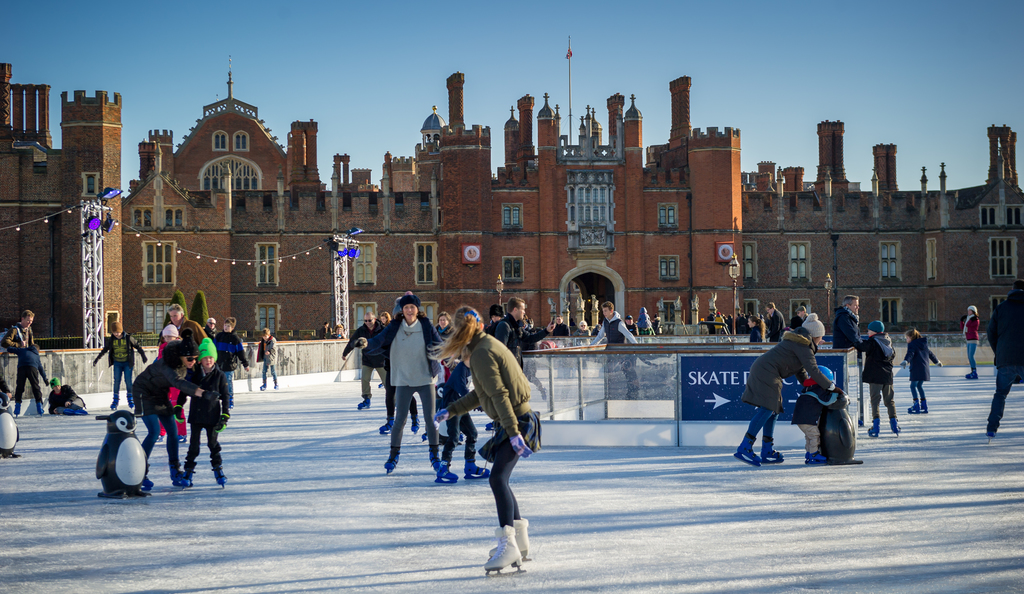Last updated: 26 June 2023
If this is the year that you’re planning on exploring the North York Moors and the surrounding areas, then you’re in for a treat because it’s a part of the country which offers visitors the best of both worlds, from rolling hills full of heather to dramatic coastal views. There’s no better place to explore on a short break so here’s our list of things to do in the North York Moors National Park.
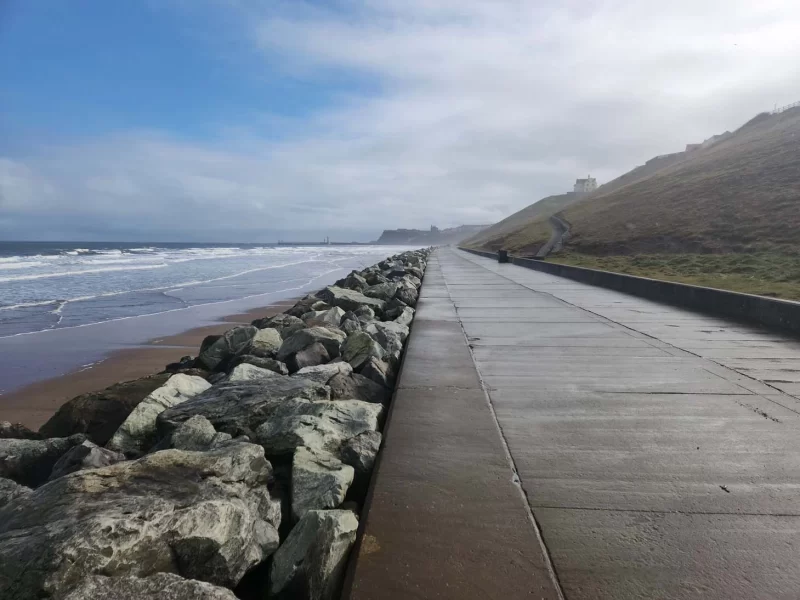
Some of the links in this post are affiliate links which means that if you click on them and make a purchase, at no extra cost to you, we may earn a small commission. This helps keep the lights on at Roaming Required HQ. We sincerely thank you for your support.
Just before we cover some of the great things you can do during a short break in the North York Moors, we thought it might be appropriate to provide a quick overview of some common questions most people have, and certainly questions we had before visiting.
Where are the North York Moors?
The North York Moors, officially known as the North York Moors National Park, is an area of 554 sq miles (1430 sq km) located in the North East of England. It encompasses a vast area of scenic natural beauty, including being the home of the largest expanse of heather moorland in England and Wales.
Is it the North York Moors or North Yorkshire Moors?
It’s definitely the North York Moors, and the name has been used since the establishment of the North York Moors National Park in 1952.
Now, without further ado, let’s delve into some of the fun and interesting things to do in the North York Moors that you should add to your Must Do List.
#1 – Dark Sky Meander & Stargazing
Location: Pickering
Did you know that the North York Moors is an internationally recognised Dark Sky Reserve? This means it’s home to some of the lowest levels of light pollution in the entire country and makes it the perfect place to go stargazing.
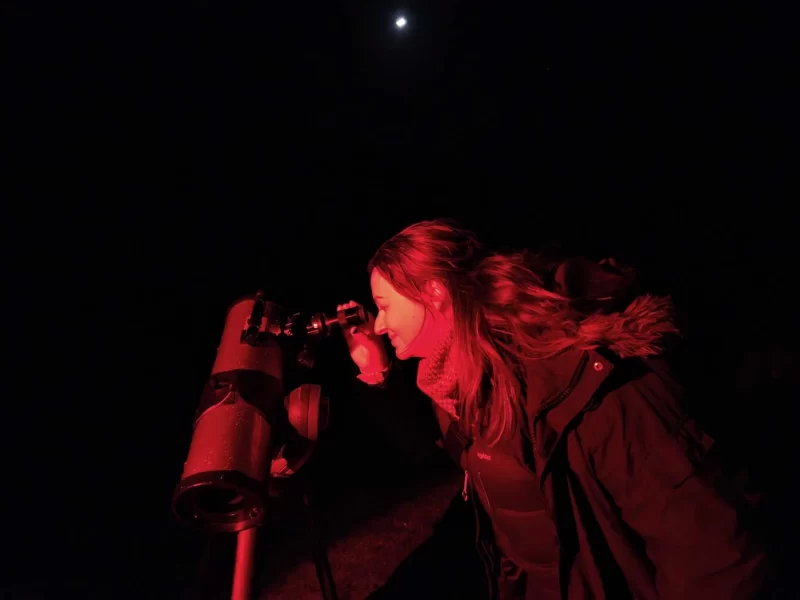
It’s easy to see why the North York Moors National Park participates in the annual Dark Skies Festival, a celebration of the night sky and all of the heavenly wonders contained therein that can only be observed in areas of the extremely low light areas, such as certain National Parks across the UK.
The North York Moors is one of only 21 global locations to be recognised for its pristine night sky.
As we’re based in London, home of the worst light pollution in England, the only stars we tend to see are those on stage in the West End so having the chance to head to the North York Moors, an internationally recognised Dark Sky Reserve, to gaze upon the mysteries of the night sky was something we were both very excited about.
The first Dark Sky Festival was held in 2016 in the North York Moors and Yorkshire Dales National Parks and has since grown in both size and scale offering visitors a plethora of activities and experiences focused on the appreciation of the dark skies. Due to the continued growth and popularity of the Dark Skies Festival, the North York Moors run a second week-long festival over the autumn months – the Dark Skies Fringe Festival – 27 October to 3 November 2023.
The Dark Skies Festival offers visitors a wide selection of various activities designed to provide an unforgettable activity that can only be experienced in a Dark Sky Reserve. The activity that Roma and I opted for was the Dark Sky Meander & Stargazing at High Dalby House in Dalby Forest.
The Dark Sky Meander & Stargazing experience is run by Alison from Adventures for the Soul, a website that specialises in the physical, mental, and spiritual benefits of embracing nature, exploring mindfulness, and the deep appreciation of the night skies.
Our Dark Sky Meander & Stargazing Experience
The evening experience began with a brief introduction from Alison to set expectations of what the evening would entail, and what the contingency plan would be in the event the cloud cover remained in place for the evening. We were also introduced to Neil and Nick, our two astronomers for the evening, who were eager to impart their knowledge about the night sky with us.
Dinner at High Dalby House
However, the first order of business was dinner, which was sumptuously prepared by High Dalby House owners, and hosts for the evening, Ian and Linda. We cannot speak highly enough of both Ian and Linda who were genuinely two of the warmest and friendliest people we’ve ever met. They went above and beyond with their delicious dinner.

Dinner was a selection of home-cooked warm and hearty dishes, which was perfect on a cold winter’s evening, and definitely required before braving the elements for our dark sly meander. Our meal included delicious classic dishes such as coronation chicken, chilli, baked potato, Waldorf salad, and a garden salad.
And as much as we enjoyed dinner, and we really did, the dessert took the whole experience to the next level. We had a slice of a brandy roll (Ian’s family recipe) and a plum crumble dessert. If you get asked if you’d like the brandy roll or the plum crumble then the answer is simply a definitive “Yes”.
The dining portion of the evening was not only delicious for the tastebuds but it naturally created a warm and friendly atmosphere as it’ll give you the opportunity to enjoy your dinner in the company with other like-minded stargazers.
Let’s Get Ready to Explore the Darkness
With our stomachs filled and the welcome warmth spreading throughout our bodies, it was now time to don our coats (on top of our thermal layers) and headlamps and head out the back garden of High Dalby House for the briefing with Alison before commencing our dark sky meander.
“Press the pause button on life and connect with nature”
Alison
There are very few times in our modern daily lives where we’ll ever have the opportunity to walk through the woods in the dark and truly engage all of our senses without the fear that comes with living in today’s world. And that is exactly what Alison offers with the Dark Sky Meander walk, a safe environment where you can engage your senses and connect with the natural world in a way that you would not otherwise be able to experience safely.
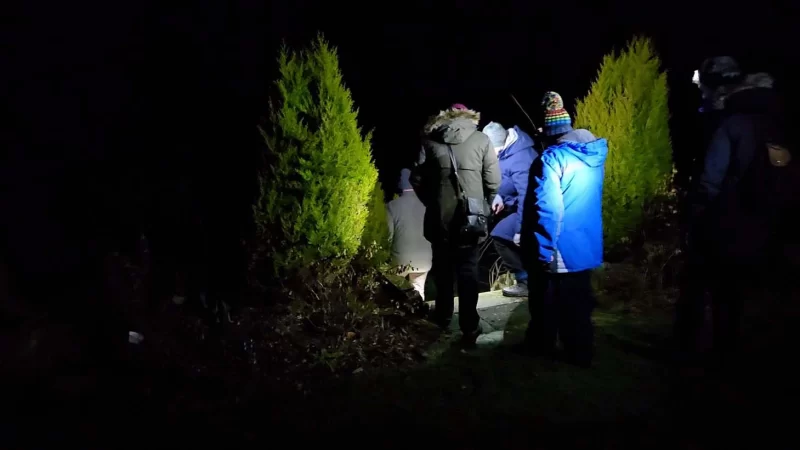
Engage your senses in the darkness
When was the last time you stopped and listened to the world around you? I mean really listened to what was around you? Have you ever stopped and just listened? Have you ever closed your eyes and stood completely still and tried to determine the direction the sounds came from? How close do you think that sound is? How about distant noise? Can you hear that?
I could hear the water from the river nearby. I heard the deep splashing of the running water but it was the moment where I focused on the distant sounds when I really discovered the magic of my dark environment. I heard the sounds of the water on the other side of the field. It was a moment of real awe, a surprising moment of discovery. I don’t know if this is what you’d call stillness but that’s what I’d describe it as. I felt at peace.
For the majority of our walk, the sky remained filled with clouds and didn’t bode well for the second part of our evening, stargazing with astronomers Nick and Neil. We knew there was a back up plan, we’d head to the chapel, a part of High Dalby House, where there’d be a virtual stargazing experience. We all held on firm to our hopes for the sky to clear.
Then something magical happened…
As our Dark Sky Meander headed into the final walk back towards High Dalby House, and the waiting telescopes on the garden lawn, we all turned around and gazed upwards to witness a sky full of stars, constellations, and the brightest moon we’ve ever seen.
It was like the heavens had decided to give us a break and command the clouds to pack up their thick and fluffy duvet which blanketed the night sky and go home, which allowed us to gaze upon more stars than I’ve ever seen in my entire life. It was, in the truest sense of the word, awesome.
Stargazing with Nick and Neil
Nick and Neil, life-long astronomers regaled us with fascinating facts about the night sky, pointed out constellations and planets with what can only be described as a lightsaber-like laser pointer, all to our amazement. We were also able to use their telescopes to experience a close-up view of the crescent moon and the lunar terminator (which we learned was the point between the light and dark halves of the moon).
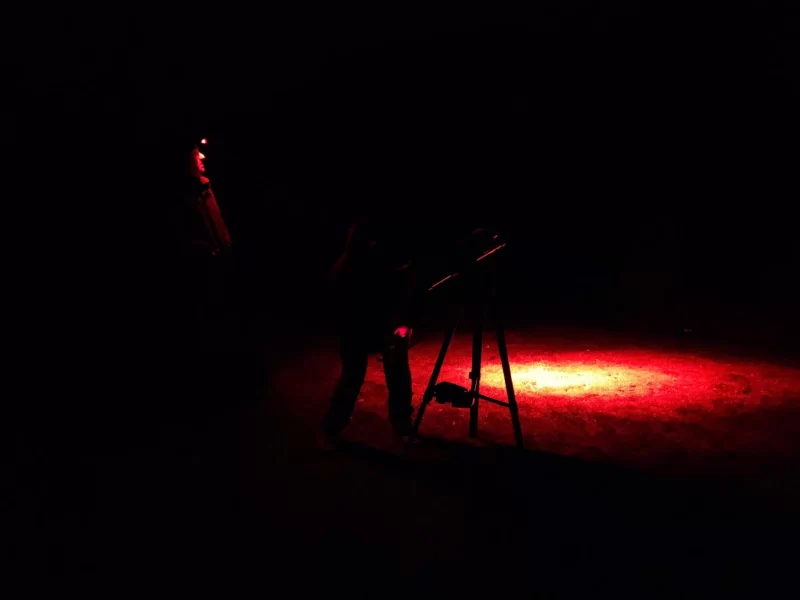
Like most people, we could tell you the names of some constellations (Ok, well, I’d be naming all the horoscopes I could think of but it would still count) but I’d never be able to tell you where they’d be in the night or even what they would look like but I can now! Nick and Neil were more than happy to point out all the constellations, stars, and planets. It was truly mesmerising.
The other important thing we learned during our dark sky meander was that the moon is one of the worst light polluters in the night sky. So whilst we were able to experience some stunning views and create memories which will last a lifetime, the oh-so-bright moon did impact the ability to capture our intended night sky photos with fabulous star trails and wondrous glimmering planets.
Verdict
Would we recommend a visit to the North York Moors for a Dark Sky Meander & Stargazing experience with Alison at High Dalby House?
Yes, in a heartbeat. It was a truly remarkable and humbling experience. One that should definitely be added to your list of things to do in the North York Moors National park.
#2 – National Centre for Bird of Prey
Location: Helmsley
If you’re looking for something unique to do during your visit to Helmsley then we can recommend the National Centre for Birds of Prey because it’s really surprising and utterly fascinating to spend some time with a multitude of birds of prey.
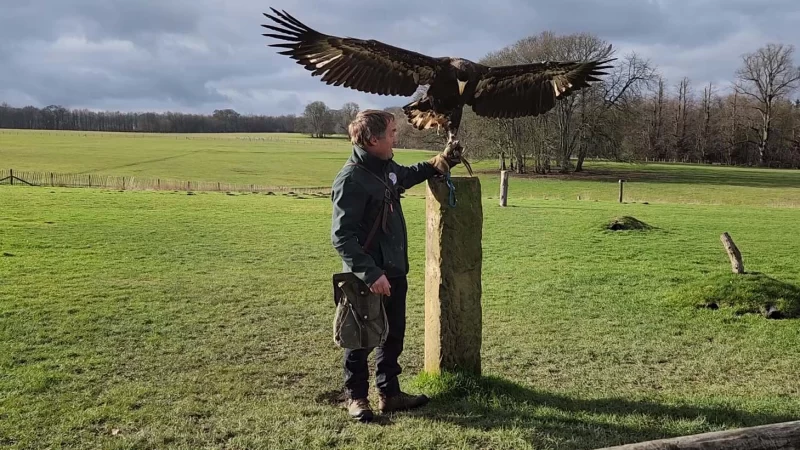
We weren’t really sure what to expect before our visit but we can tell you now that the next time we’re in the area, we’ll be going back for another visit. There’s much to appreciate from a visit – from the awe-inspiring flying demonstrations, to discovering and learning about the many different birds that live onsite, and the ability to explore the grounds at your leisure.
What is the National Centre for Birds of Prey?
The National Centre for Birds of Prey offers visitors the opportunity to discover the largest collection of birds of prey in the north of England. The team specialise in captive breeding and conservation to protect these amazing birds which you will be able to witness during a visit. We suggest that you take your time during your visit and explore all the different areas on offer, which the below map outlines and should help you with planning your visit.
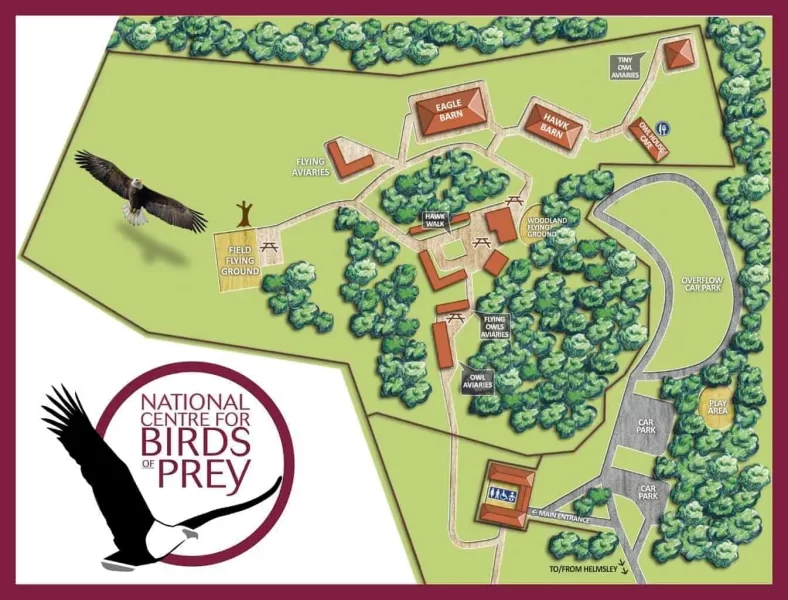
Exploring the National Centre for Birds of Prey
The main entrance to the National Centre for Birds of Prey is where you can purchase your tickets before heading outside along a path leading to the first set of aviaries.
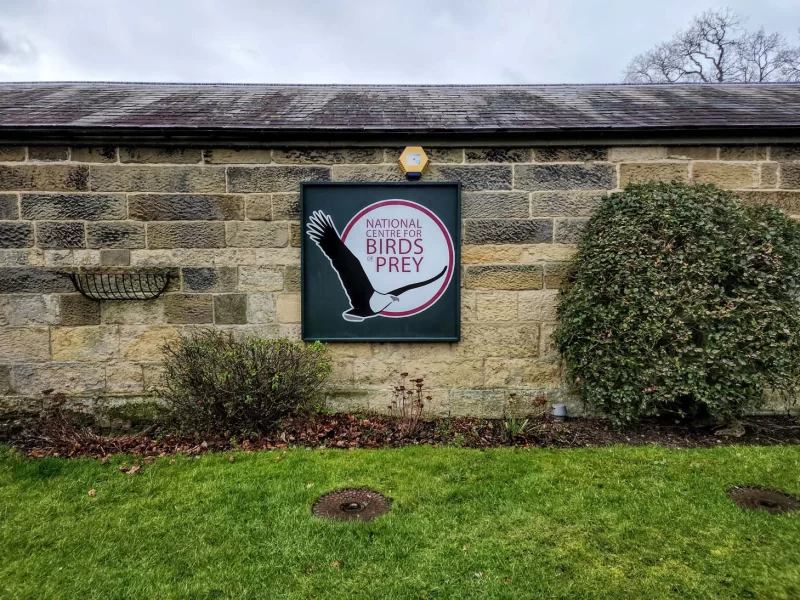
Owl Aviaries
This was the first time that we’ve ever come face to face with owls, outside of watching the Harry Potter films, and it felt unreal! I think the most surprising thing was that some of them were considerably larger than expected and they have a penetrating gaze which will see right through you.
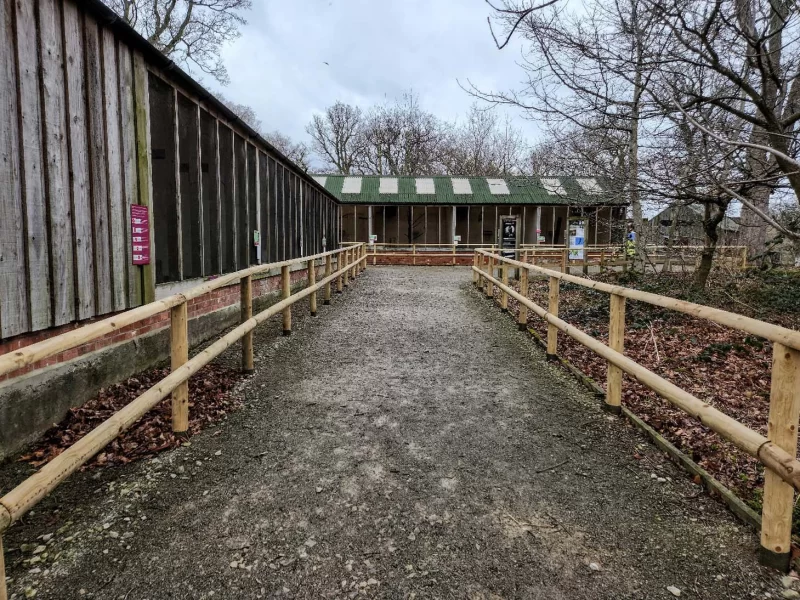
Each of the aviaries are signposted with the type of owl, the part of the world they come from, and some really interesting facts, such as; Owls have twice as many neck vertebrae as a giraffe and can turn their heads 270 degrees!
Hawk Walk
Following the path through the owl aviaries will lead you to the Hawk Walk, where you can find a selection of trained birds, which will change over the course of the year, ranging from Hawks, Falcons, Buzzards, and Eagles.
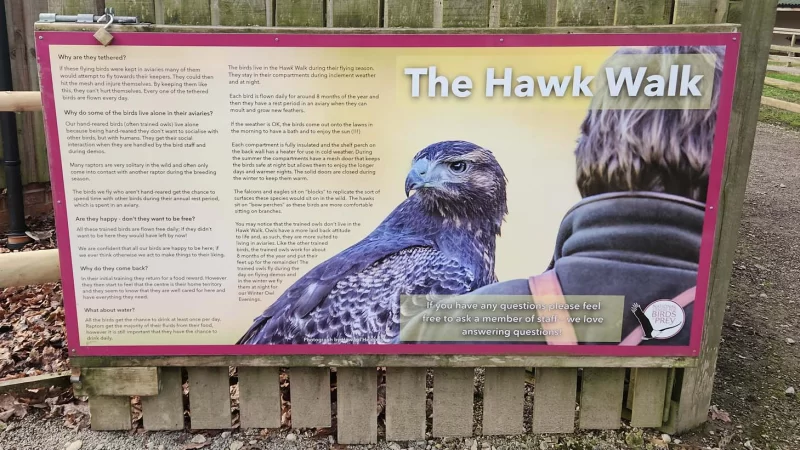
It’s an open area where the birds are secured with a tether rather than behind wire which means that you can get close for photos and if it’s not really cold when you visit then you might see the birds enjoying the lawn area for bathing. However, it was pretty cold when we visited so most of the birds in the Hawk Walk were enjoying the heated and insulated compartments.
The Flying Grounds
From the Hawk Walk, you can head to the Flying Grounds for one of the best reasons to visit the National Centre for Birds of Prey – the flying demonstrations. It’s an absolute must!
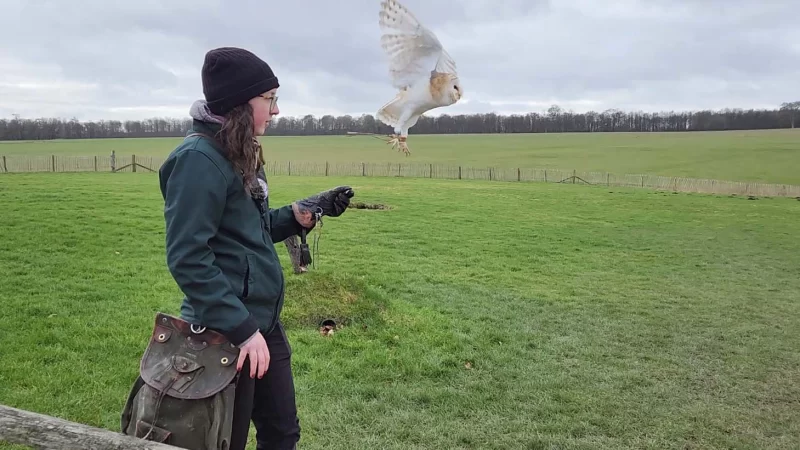
The viewing area for the flying demonstrations are a series of wooden benches, where you can perch (pun intended) and some picnic-style tables at the rear. The good news is that there’s no need to rush to the front to get the best views because the flying demonstrations are run in such a way that everyone, no matter where you’re seated, will get a terrific view of the birds doing what they do best.
The National Centre for Birds of Prey staff members who run the demonstration are experts and thoroughly entertaining. It really helped us understand so much about the birds, such as their life story, their lifestyle, history, and eating habits. During our visit we observed a Barn Owl, Stella Sea Eagle, Horned Grey Owl, and a Falcon.
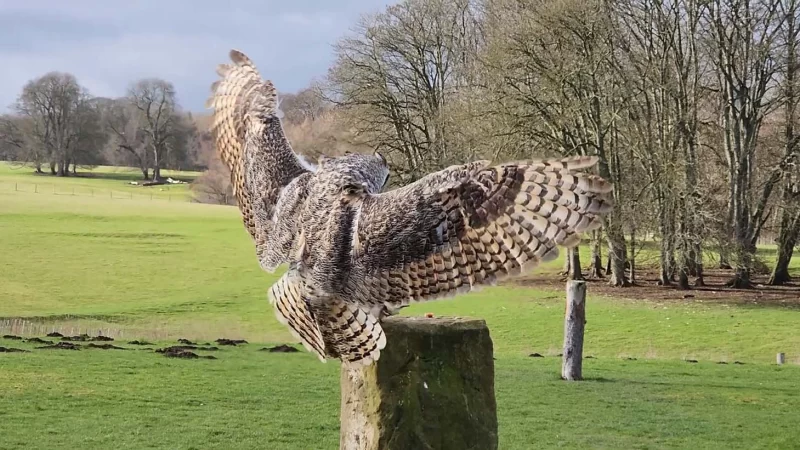
The length and numbers of birds flown during the daily flying demonstrations does differ over the summer and winter months. Also, the number of shows over the warmer months will increase with a third demonstration in the late afternoon.
Some of our highlights included;
- Seeing a Stella Sea Eagle for the first time. They were huge! So much larger than I expected and even as I write this I can’t think of a time where I was so close to such a large bird.
- Spending some time learning about vultures, their role in nature, and why they look the way they look. Fascinating.
- Owls! We had no idea about the huge variety of owls so it was really interesting visiting their dedicated aviaries to learn more about them. It was a real…. (wait for it)….HOOT (sorry, not sorry).
Eagle Barn / Hawk Barn / Tiny Owl Aviaries
Following the flying demonstrations, we suggest you head over to the section of the centre where the Eagle Barn, Hawk Barn, and Tiny Owl aviaries are located to experience some more incredible birds in larger aviaries.
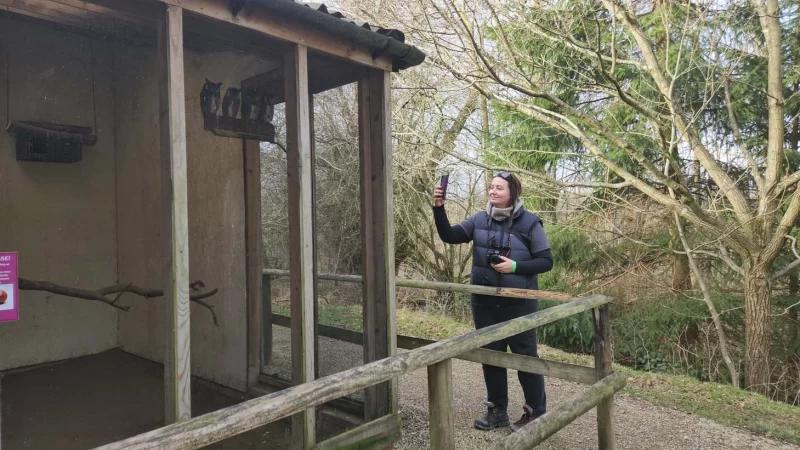
One of the biggest surprises was coming across the vultures, which we didn’t expect to see, but we found them really interesting. The aviaries have some compelling signs which provide some interesting facts about why vultures look the way to do.
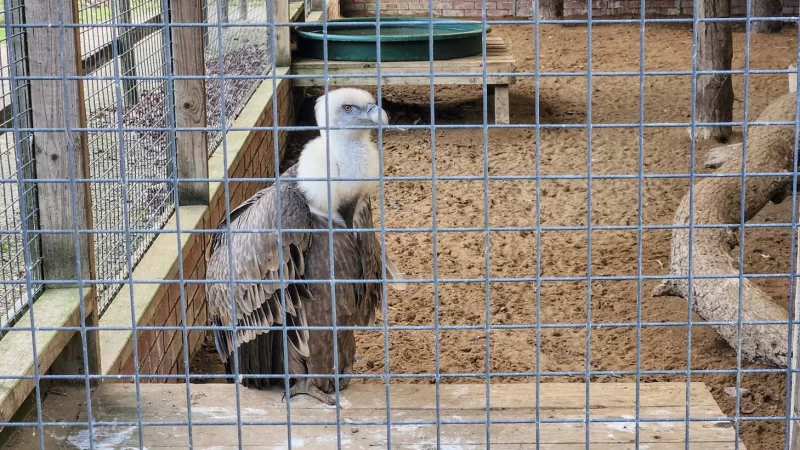
A good way to end your visit to the National Centre for Birds of Prey is with a trip to the onsite Owl House Cafe where you can pick up a snack or a drink and review the many (many) photos you’ve captured during your visit.
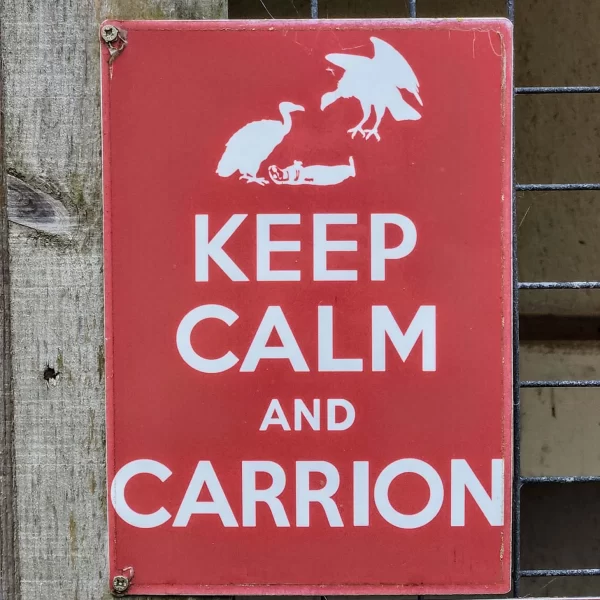
Verdict
Would we recommend a visit to the National Centre for Birds of Prey? Yes, definitely!
READ MORE: Latest Posts from Roaming Required
#3 – Explore the Market Town
Location: Helmsley
Helmsley, a charming storybook-like English village, the type of quintessential village you’d likely find on a postcard in a tourist information office. It is the only market town in the entire North York Moors National Park, and is a popular respite for those seeking rest and relaxation over a weekend or short break.
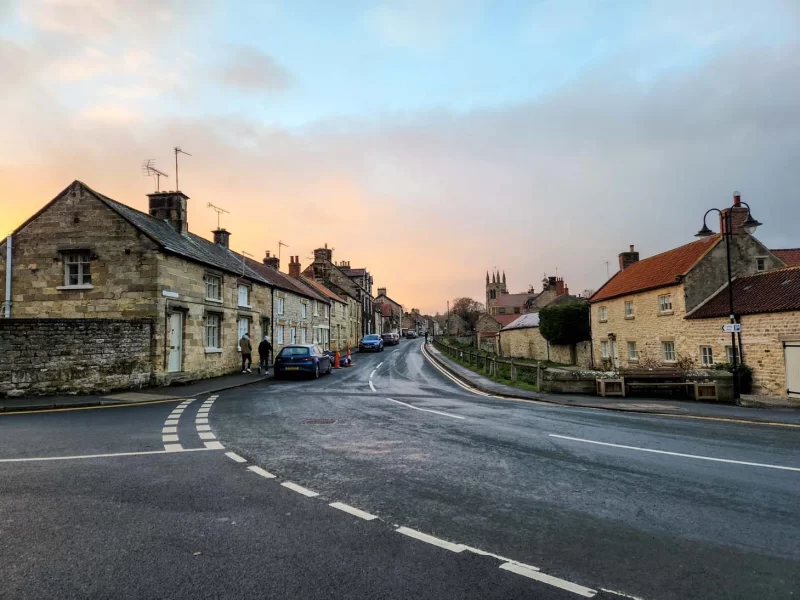
During our short visit, we discovered that Helmsley is also a photographer’s delight with its mix of architectural marvels, historic ruins, and market square reaching back hundreds of years, all on display within an easy amble from each other.
Take a Walk and Explore
Sometimes the hardest decision to make when exploring a new town or village is to pick a direction when taking a walk for fear of picking the wrong one, fortunately that’s not an issue in Helmsley because all directions will lead you to something to admire. Whether that’s a historic market square, wonderfully symmetrical Georgian architecture, or the remains of a grand medieval castle.
The Black Swan
Located at one side of the market square is the famous Black Swan, a popular hotel which dates back to the 15th, and served as a coaching inn for weary visitors who were travelling between Leeds and York.
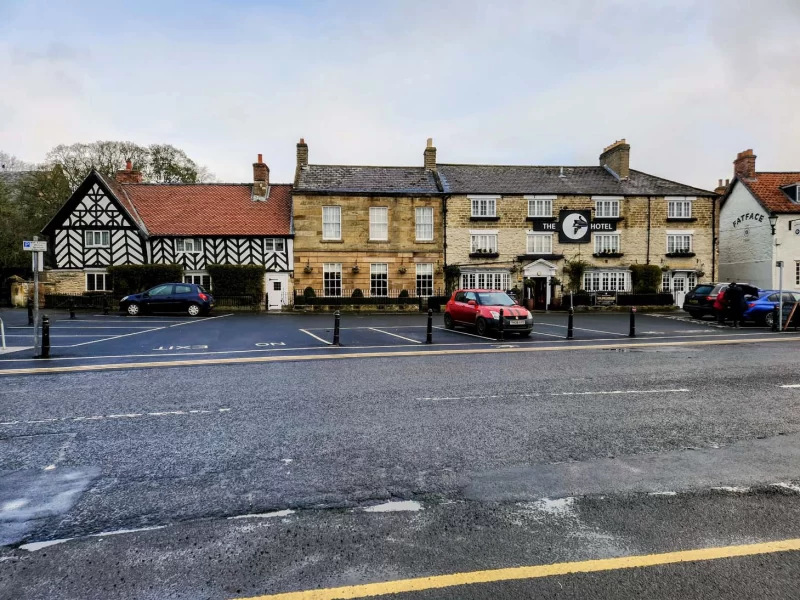
RR Recommendation: Take a moment and stand outside the Black Swan Hotel and admire the unique building design which comprises Tudor, Elizabethan, and Georgian architectural designs. It is really something fascinating.
The Church of All Saints
Located just around the corner from the market square is the Church of All Saints which dates back to the mid-19th century but stands on Norman foundations from over 1000 years ago. The church also features in the Domesday Book of 1086 which confirms the historic status of a church in Helmsley. The Church of All Saints operates regular services and Holy Communion, and if you time your visit just right then you’ll see it light up in the afternoon sun.
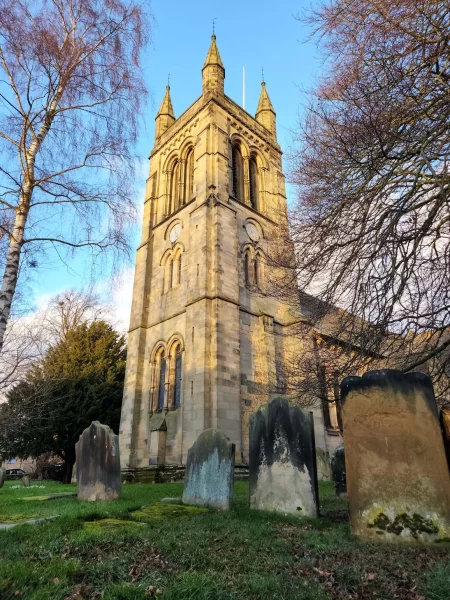
Helmsley Castle
The historic remains of Helmsley Castle can be seen peeking over the tops of houses and businesses which highlights just how close everything is in town. A short walk from the market square will bring you to the gates of Helmsley Castle and over 900 years of history within almost touching distance.
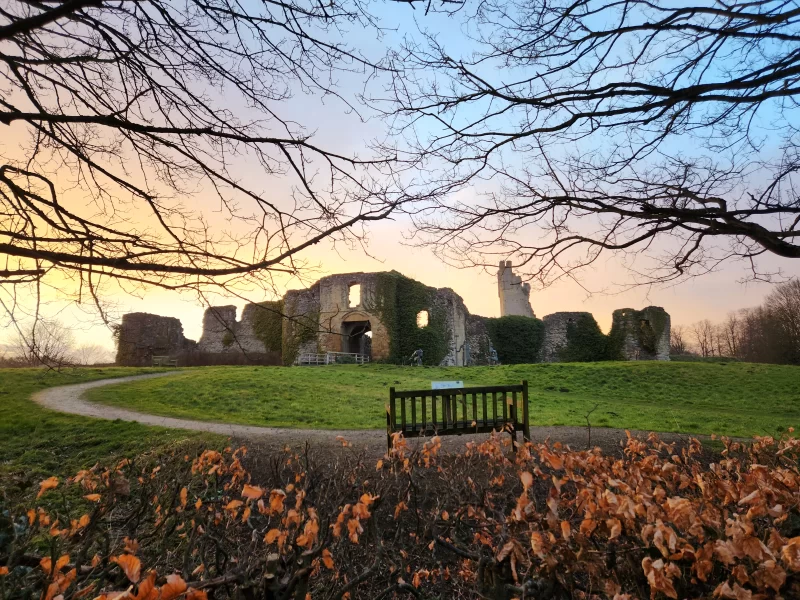
It is worth noting that Helmsley Castle, part of English Heritage, does offer varying prices and hours of operation depending on the time of year so check the website for the specific hours for your intended visit.
There’s something remarkably soothing for the soul in being able to amble without a specific direction in mind and enjoy the array of views which unfold street after street in Helmsley. Take your time and notice the streets, the buildings, and just imagine what life was once like on these roads over the centuries gone by.
Helmsley Brewing Co.
A good walk around town might make you thirsty so we recommend heading to Helmsley Brewing Co., a local micro-brewery, which is not only dog-friendly (to our delight) but also provides a selection of locally brewed beers, including the Golden Ale which we thoroughly enjoyed. We’ve earmarked the Helmsley Honey for our next visit.
One standout from our visit to Helmsley Brewing Co. was just how friendly everyone was, especially some of the locals. Given the fact that we walked in carrying a rather large camera, it was pretty obvious that we were from out of town but were warmly greeted, which is exactly what you want from a visit. The beer selection was clearly explained and then ordered whilst one of the locals happily talked to us about our camera rig.
Thanks for the warm welcome, Helmsley Brewing Co., we shall be returning.
La Trattoria Restaurant
If you’re looking for dinner recommendations then we think you can’t go past a meal at La Trattoria, which was easily one of the best meals we had during our time in the North York Moors.

Verdict
It’s easy to see why Helmsley is a popular destination for people wanting to get away for the weekend or a short break so we will definitely be returning and recommend you plan a visit too.
#4 – The Cleveland Way
Location: Whitby
One of the most popular things to do during a visit to the North York Moors National Park is to get out into the fresh air and experience the incredible expanse of nature first-hand with a walk through the countryside or along the coast. Or both!
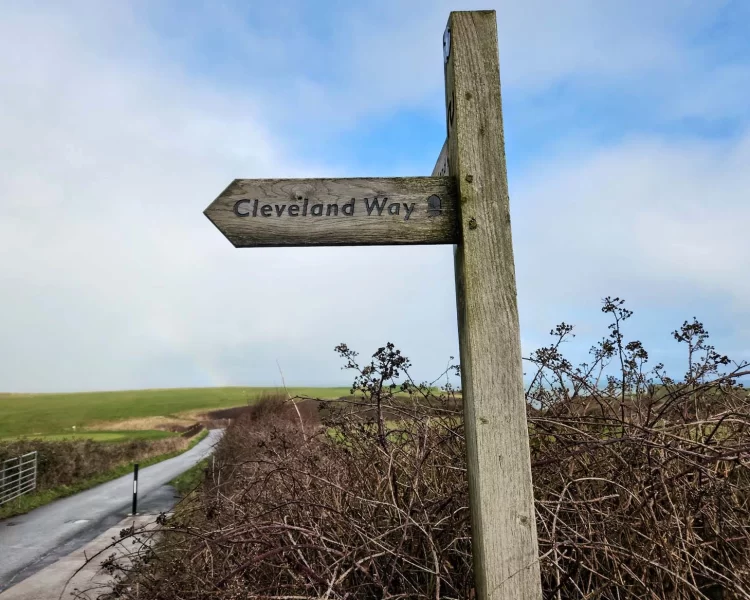
What is the Cleveland Way?
The Cleveland Way is a 109 mile (175 km) walking route through the beautiful and varied landscapes that can be experienced throughout the North York Moors National Park, and best of all, the walk is accessible all year round.
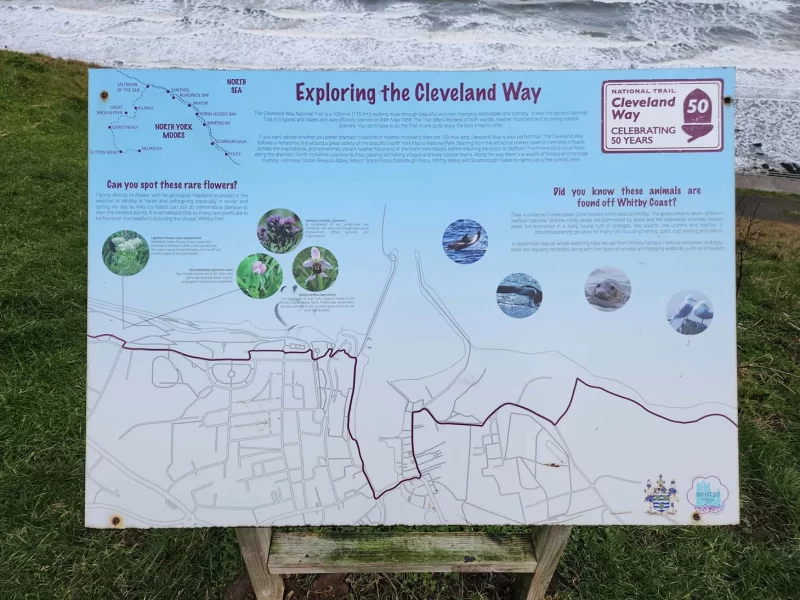
Starting in Helmsley and ending in Filey Brigg, the 109 mile walk will treat you to a visual feast of landscaped delights that can only be found in the North York Moors – from the largest expanse of heather moorland in England and Wales to dramatic coastal views of the North Sea.
Depending on your time available and your overall general fitness, you can walk all 109 miles of the Cleveland Way or complete a section of the great trail, which is exactly what we did during our time in the coastal town of Whitby.
Where is the Cleveland Way in Whitby?
The start of the Cleveland Way in Whitby is located near Whitby Golf Club, just opposite the Sandfield House Farm Caravan Park, which is where you’ll find the above signpost marking the Cleveland Way. Follow the trail through the winding downhill path and soon you’ll find yourself faced with the beautiful view of the North Sea.
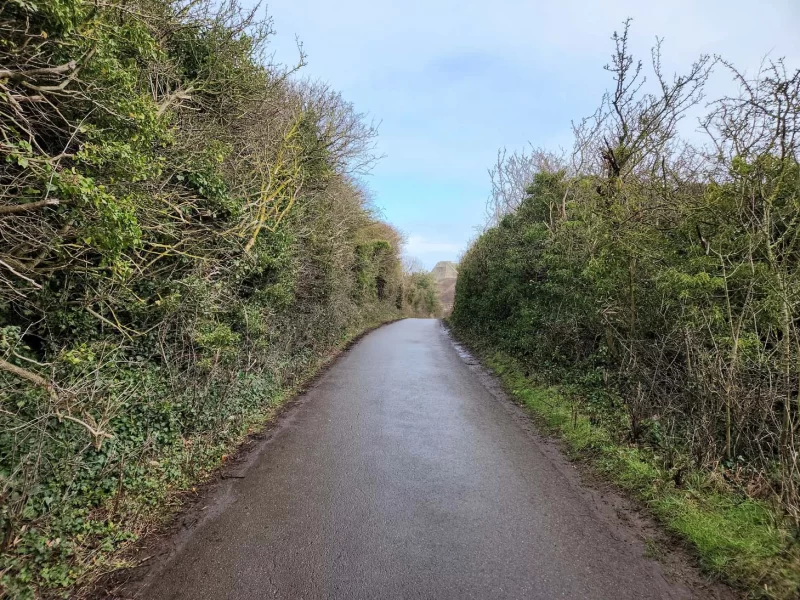
From here, you will be able to walk along the Whitby promenade taking in sea views and feeling the sea spray on your face. I don’t know about you but just sitting on the edge of the walking path and staring out over the cresting waves always makes my heart sing and calms the spirit. Time well spent on this walk.
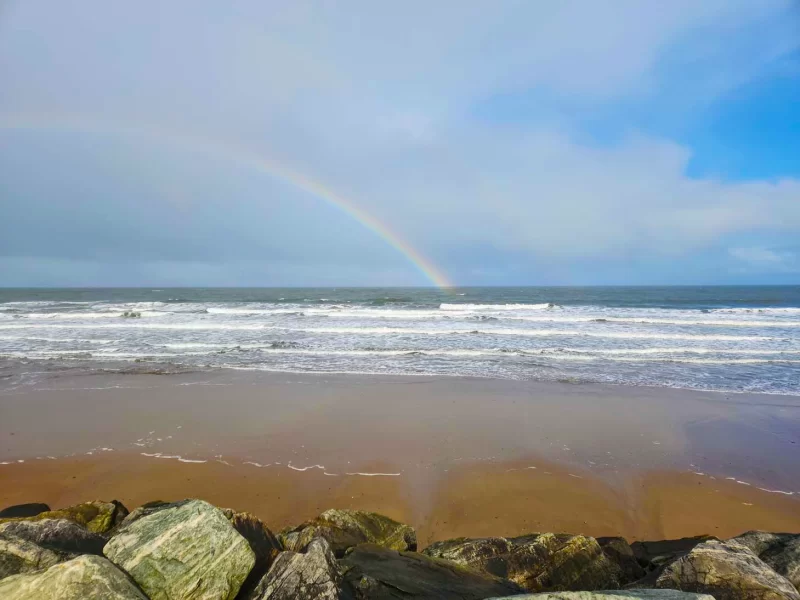
Verdict
If you’re after some time to decompress and de-stress in the great outdoors then the Cleveland Way is what you’ve been looking for. It’s a walking trail which will provide a combination of varied landscapes and provide a real ability to reconnect with nature. And don’t forget that you can do as much or as little of the 109 miles trail as you wish. You choose.
#5 – Whitby Abbey
Location: Whitby
One of the highlights of walking the Cleveland Way in Whitby is that it will wind its way to Whitby Abbey, one of the most iconic and enduring symbols of the town, and personally one of our favourite medieval ruins in all of the UK.
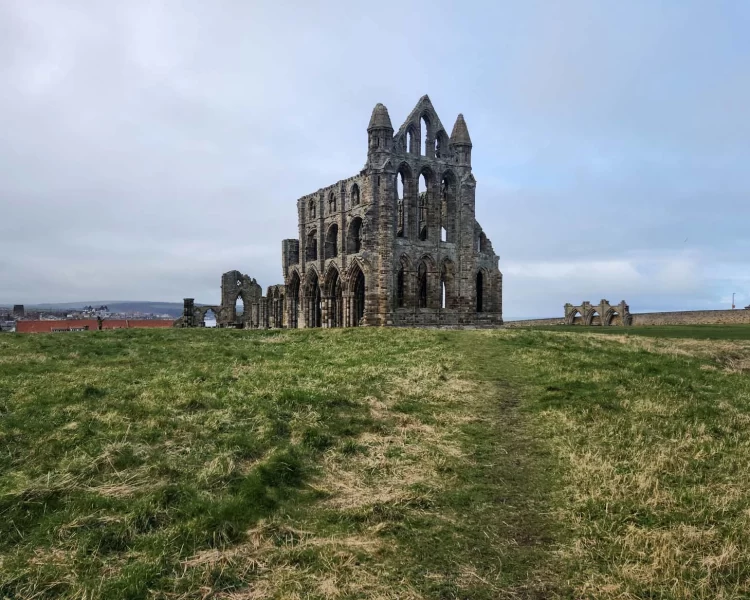
What is Whitby Abbey?
Whitby Abbey, part of English Heritage, is a wonderfully romantic gothic ruin which impresses the eye, captures the heart, and impresses upon your soul the centuries of life which existed in the spot where you’re standing.

A (very) Brief History of Whitby Abbey
When visiting Whitby Abbey you’ll learn that the history of the church ruins pre-dates the church itself and dates back to the 7th century when St Hild founded the first monastery which survived for about 200 years before it was abandoned due to Viking raids. The monks returned in the 12th century but nothing remains of their stone church. The ruins you see today are from the 13th to 15th century.
It’s easy to see why multiple churches have existed in this spot high above Whitby, it’s a beautiful part of England, and a reminder of the natural beauty which surrounds us all.
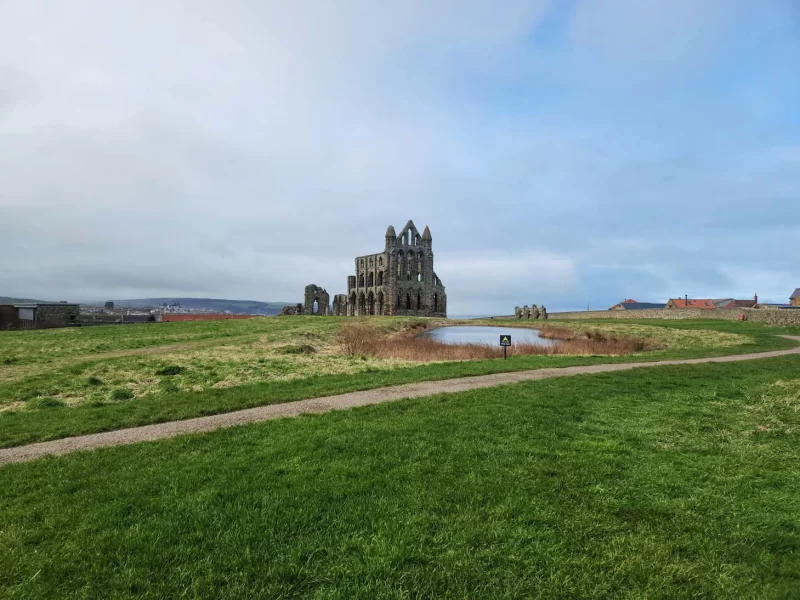
Whitby Abbey, Bram Stoker, and Dracula
Whitby Abbey is perhaps best known today as the inspiration for Bram Stoker’s seminal novel, Dracula, in 1897. A young Bram Stoker would often sit in the town of Whitby and gaze up at Whitby Abbey whilst writing his novel, infusing the Gothic ruins with another historical figure that only recently learned about in the local library, the Romanian ruler, Vlad Tepes, also known as Vlad the Impaler or Vlad Dracula.

Explore the Visitor Centre
Whitby Abbey is part of English Heritage so if you’re a member then you’ll be able to explore the Abbey ruins for free. The newly renovated visitor centre, and take a walk through the Abbey grounds.
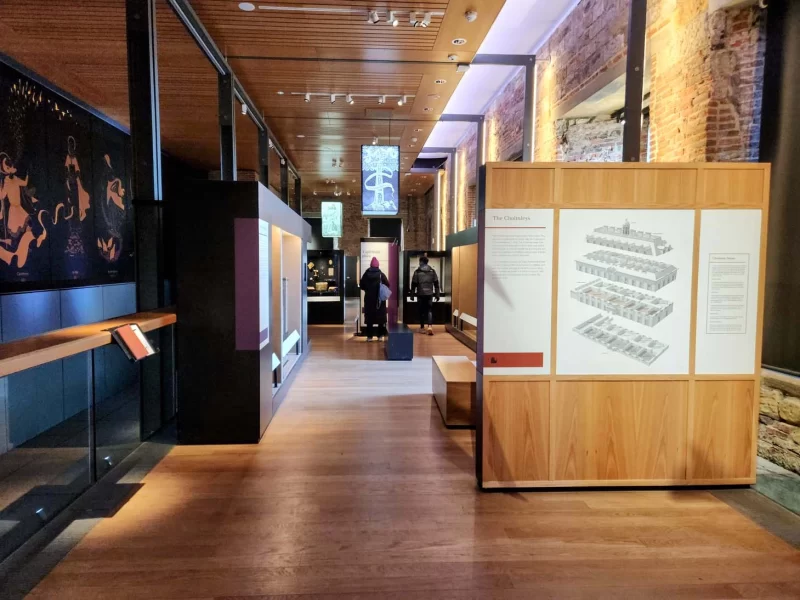
Verdict
One of the reasons why Roma and I feel such affection for Whitby Abbey is because it was one of the very first historical ruins we visited when we first arrived in the UK a decade ago and the memory of how awed we were gazing upon its ornate ruins left an indelible mark. A visit is highly recommended.
#6 – Captain Cook Connection
Location: Whitby
During our time in Whitby we were genuinely surprised to learn that the town has a long connection with Captain James Cook, who was the first recorded European explorer to reach the south-eastern Australian coastline in 1770. It’s because of this connection between Whitby and Captain Cook that there is a commemorative statue located overlooking the Whitby harbour.
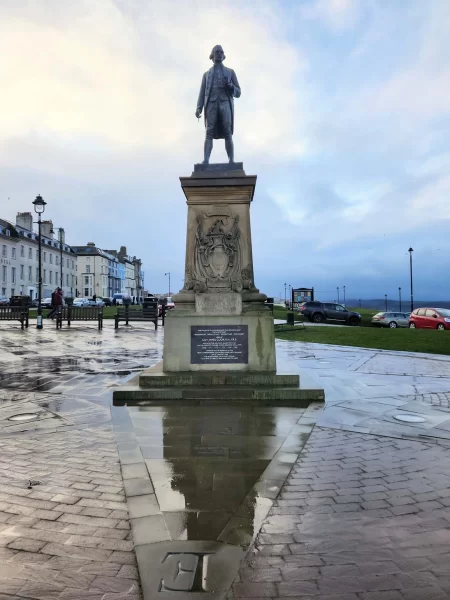
Who was Captain James Cook?
Whitby was where a young James Cook undertook his maritime apprenticeship under John Walker, a local ship owner. Following the apprenticeship, he joined the Royal Navy and rose through the ranks to become a respected captain commanding several vessels on various expeditions in the South Pacific. The Endeavour, the most famous of Cook’s ships, was the one that was used to chart New Zealand and the eastern coastline of Australia.
What were Captain Cook’s Most Famous Ships?
Whitby has a long maritime history and was the location where four of Captain Cook’s most famous ships were built – Endeavour, Resolution, Adventure, and Discovery.
The Captain Cook Memorial
The memorial was unveiled in the presence of the High Commissioners of Australia and New Zealand on 26 August 1968, the bicentennial of the 1768 journey of discovery which led to his arrival in New Zealand and Australia.
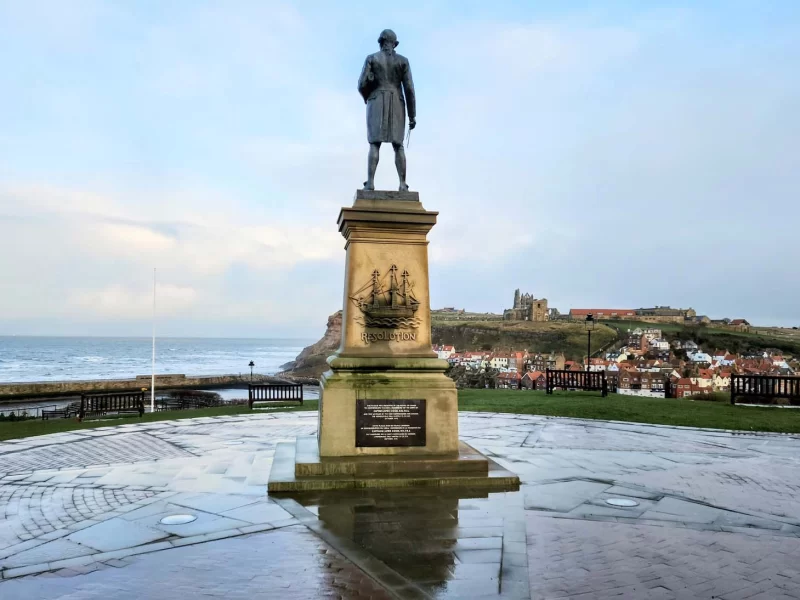
The statue contains four plaques presented by Australia, New Zealand, and Canada. One of the plaques is dedicated to the men who built the Whitby ships.
Captain Cook Memorial Museum
If you’re interested in learning more about Captain James Cook and his many voyages then you might be interested in visiting the Captain Cook Memorial Museum which is located a 10 min walk from the memorial.
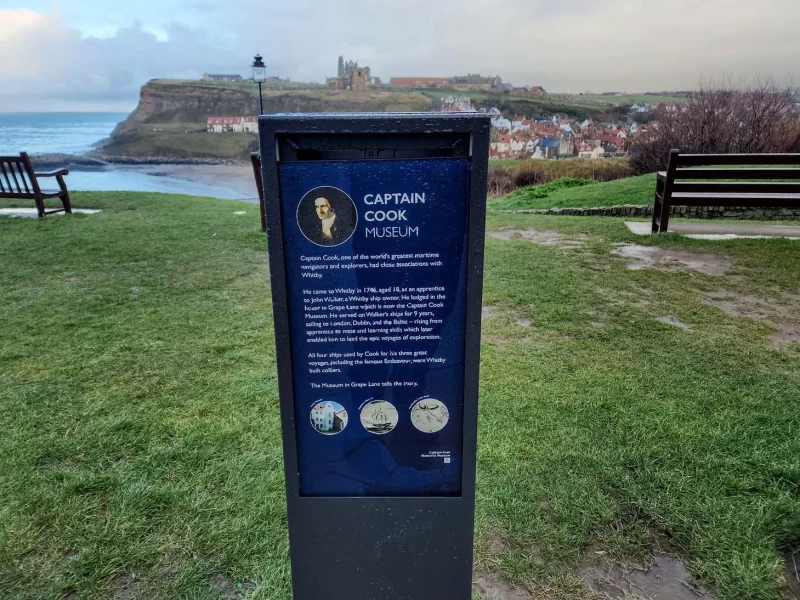
The museum is located in the 17th century house, many rooms still have the original paneling, where Captain Cook lived when he was undertaking his apprenticeship in Whitby. The museum offers visitors the opportunity to walk the footsteps of a young James Cook whilst learning about his life at sea, and in Whitby.
Whalebone Arch
Located right next to the Captain James Cook Memorial is the Whalebone Arch, a replica whale jawbone. The original jawbone arch erected in 1963, dedicated to the men who “braved the inhospitable seas”, became weather-beaten over time and was replaced with this replica. This arch commemorates Whitby’s history of whaling and the 55 whaling ships that were in operation between 1753 and 1833.
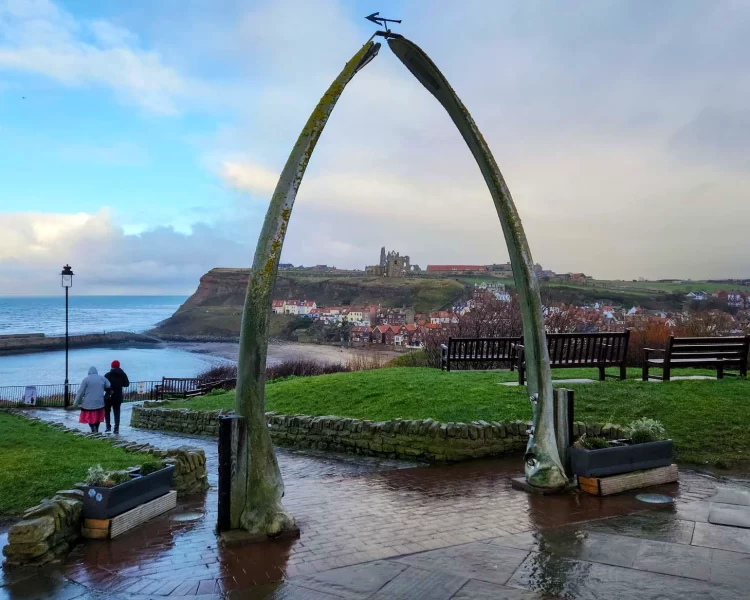
Verdict
If you’re interested in learning about the history of Whitby then we suggest taking a short walk from the promenade and visiting these two memorials. We think it’s important to learn about history, even the parts that might make you feel uncomfortable, because it’s only by understanding the past that you can positively impact the future.
#7 – Bombardment Garden
Location: Whitby
Did you know that Whitby was the target of a shelling attack during the First World War?
First World War Attack in Whitby
The Bombardment Garden is a memorial to the 1914 bombing attack by two German battle cruisers when, at 09:05 am, they appeared out of the mist and launched at least 100 shells into the town of Whitby for about seven minutes. The target was likely the railway station where most of the damage was sustained however up to 30 thirty houses were damaged and two people lost their lives.
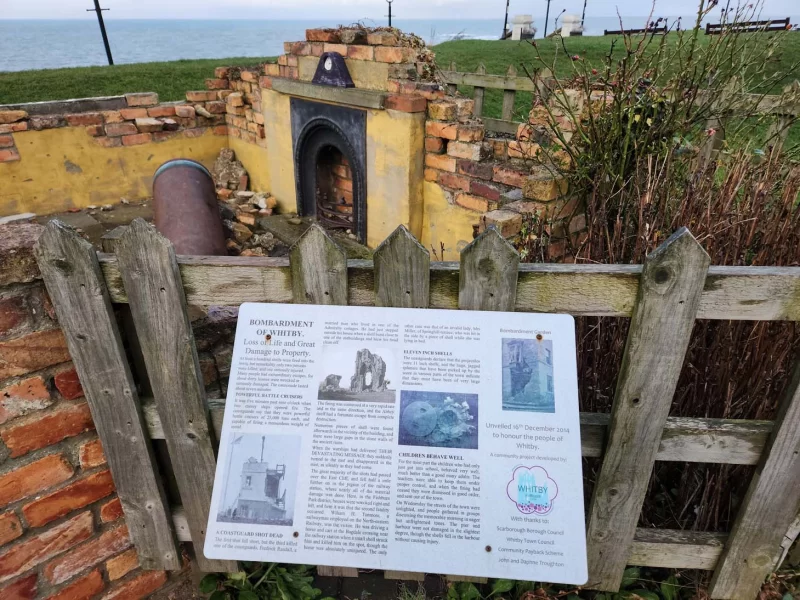
Was Whitby Abbey Attacked During World War I?
Following the shelling attack on Whitby by the German battle cruisers, Whitby Abbey fortunately remained standing however there were shells located in the area and large holes in some parts of the walls indicated that some damage had been incurred.
The Bombardment Garden Memorial
The Bombardment Garden commemorates the shelling attack and was unveiled on 16 December 2014.
Verdict
This unexpected memorial on the Whitby seafront is worth visiting to learn about the shelling attack but also to appreciate the time and effort that went into creating this striking display.
Final Thoughts
There are just so many things to experience during a short break in the North York Moors National Park that it’s just not possible to do them all on a single trip but we do hope that this list encourages you to book your own trip to explore the North York Moors.
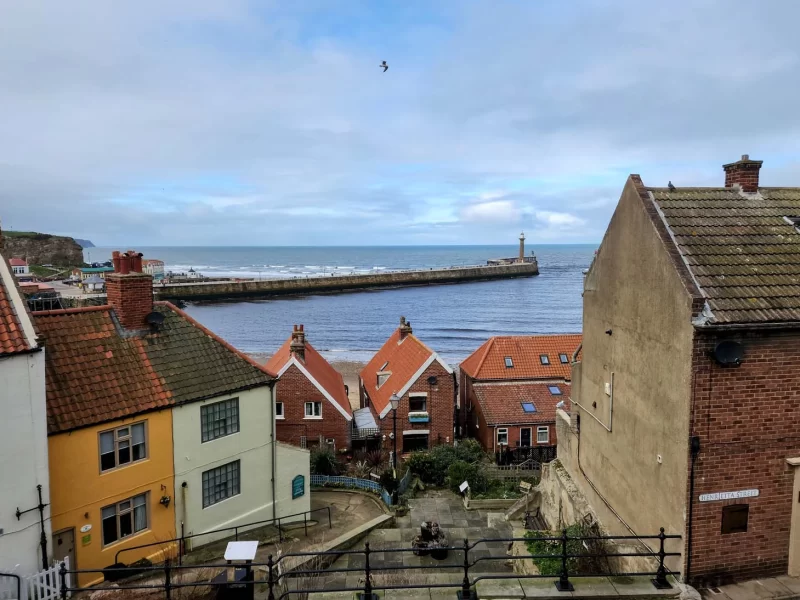
If you’re looking for more details about the North York Moors then we recommend checking out the North York Moors National Park website
Disclaimer: Roaming Required partnered with North York Moors for this campaign and retained editorial control over all content created and shared. All opinions have been freely expressed and remain our own.
READ MORE




